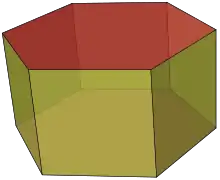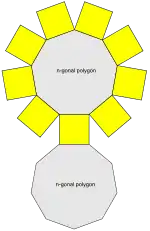Prism (geometry)
A prism is a three-dimensional shape, which is made of two polygons at each of its two ends. Each pair of polygon sides on the same axis will have a quadrilateral (four-sided shape) face between them.
| Set of uniform prisms | |
|---|---|
 (A hexagonal prism is shown) | |
| Type | uniform polyhedron |
| Faces | 2+n total: 2 {n} n {4} |
| Edges | 3n |
| Vertices | 2n |
| Schläfli symbol | {n}×{} or t{2, n} |
| Coxeter-Dynkin diagram | |
| Vertex configuration | 4.4.n |
| Symmetry group | Dnh, [n,2], (*n22), order 4n |
| Rotation group | Dn, [n,2]+, (n22), order 2n |
| Dual polyhedron | bipyramids |
| Properties | convex, semi-regular vertex-transitive |
 n-gonal prism net (n = 9 here) | |
There are an infinite number of different prisms, which can be based on a polygon with any number of sides.
A cube is a special kind of prism with squares for the faces on its ends and for the faces between them.
This article is issued from Wikipedia. The text is licensed under Creative Commons - Attribution - Sharealike. Additional terms may apply for the media files.



























